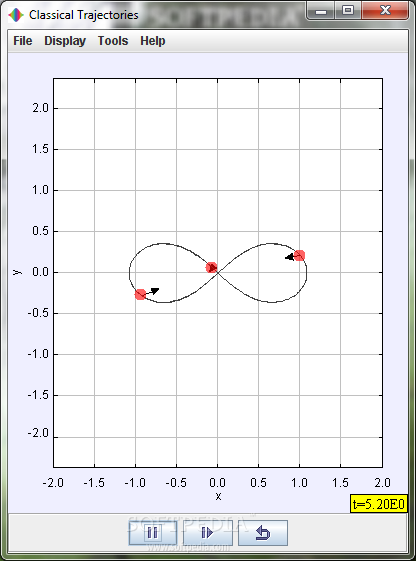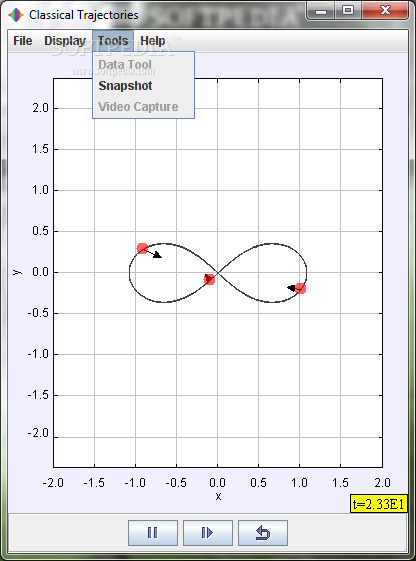Description
Orbit Program - Gravitational Interaction Simulator Download

Orbit Program offers a fascinating window into the complex world of gravitational dynamics through an intuitive Java-based interface. This powerful simulation tool allows users to visualize and study how multiple massive objects interact when subjected to gravitational forces.
When you download Orbit Program, you'll gain access to a versatile application that brings celestial mechanics to life on your computer screen. The program renders complex orbital patterns with precision, making it an excellent resource for students, educators, and astronomy enthusiasts.
Key Features of Orbit Program
The default configuration showcases the remarkable figure-eight orbit of three particles—a mathematical discovery first identified by Montgomery that demonstrates how three bodies of equal mass can maintain a stable, periodic orbit under mutual gravitational attraction. This phenomenon, challenging to visualize without computational assistance, becomes immediately apparent when using Orbit Program.
Beyond this initial scenario, Orbit Program provides extensive customization options. Users can modify parameters, add additional objects, and experiment with different initial conditions to observe how gravitational systems evolve over time. The simulation software accurately calculates trajectories based on established physical laws.
User-Friendly Interface
Orbit Program stands out among gravitational simulation tools for its accessible interface. Despite handling complex calculations behind the scenes, the application presents results in a clean, visually appealing format that makes orbital dynamics comprehensible even to beginners.
The program's intuitive controls allow for real-time adjustments to simulation parameters. By accessing the Display | Switch GUI menu option, users can specify new particles with custom initial positions and velocities, enabling endless experimentation with different gravitational scenarios.
Educational Applications
For educators teaching physics or astronomy, Orbit Program download provides an invaluable classroom tool. The visual nature of the simulation helps students grasp abstract concepts like orbital mechanics, gravitational attraction, and conservation of angular momentum through direct observation rather than purely mathematical descriptions.
The software bridges theoretical physics with visual representation, making it easier to demonstrate complex phenomena like the three-body problem, which has no general analytical solution but can be explored through numerical simulation.
Technical Specifications
- Platform: Cross-platform (Windows, macOS, Linux)
- Requirements: Java Runtime Environment (JRE)
- File Size: Approximately 2.5 MB
- License: Free for educational and personal use
- Latest Version: 2.3.1
System Requirements
- Java Runtime Environment 8 or higher
- 1 GHz processor (2 GHz recommended for complex simulations)
- 512 MB RAM (1 GB recommended)
- 50 MB free disk space
- OpenGL-compatible graphics card for optimal performance
Advanced Simulation Capabilities
The gravitational simulation software offers precision that makes it suitable even for more serious astronomical research projects. The program implements numerical integration algorithms that accurately calculate the complex interactions between multiple bodies, providing insights into chaotic systems and orbital stability.
When you download Orbit Program, you'll be able to adjust simulation parameters including time step, gravitational constant, and integration method to balance between computational speed and accuracy according to your specific needs.
Visualization Options
The software provides multiple display options to enhance understanding of the simulated systems:
- Trajectory tracing to visualize complete orbital paths
- Color-coding of objects based on mass or velocity
- Zoom functionality to examine specific interactions
- Optional velocity vectors to indicate direction and speed
- Data export capabilities for further analysis
Why Download Orbit Program?
Whether you're a student exploring the fundamentals of orbital mechanics, a teacher seeking to demonstrate gravitational principles, or simply someone fascinated by celestial dynamics, Orbit Program offers an accessible yet powerful simulation environment.
The gravitational simulation software strikes an ideal balance between scientific accuracy and user-friendly operation. Its Java foundation ensures compatibility across different operating systems, making it accessible regardless of your preferred computing platform.
Orbit Program maintains active development, with regular updates introducing new features and refinements to the simulation engine. By downloading the latest version, you'll benefit from ongoing improvements to both functionality and performance.
Community Support
Join a community of educators, students, and astronomy enthusiasts who use Orbit Program to explore gravitational dynamics. Online forums provide opportunities to share interesting configurations, discuss simulation results, and receive assistance with advanced features.
Experience the fascinating world of gravitational interactions through this elegant, educational application. Download Orbit Program today and begin exploring the beautiful complexity of orbital dynamics on your own computer.
```
User Reviews for Orbit Program 13
-
for Orbit Program
Orbit Program is a fascinating Java app demonstrating gravitational interactions of massive objects. Customizable scenarios offer educational value.
-
for Orbit Program
The Orbit Program is fantastic! It's incredibly intuitive and visually captivating. Highly recommend!
-
for Orbit Program
I love this app! The gravitational dynamics simulation is impressive and educational. Five stars!
-
for Orbit Program
Orbit Program exceeded my expectations! The figure-eight orbit feature is fascinating and easy to use.
-
for Orbit Program
This app is a gem for physics enthusiasts! It beautifully demonstrates gravitational interactions. A must-have!
-
for Orbit Program
Outstanding application! The ability to customize particle positions adds a unique touch to the experience.
-
for Orbit Program
Absolutely brilliant! The visuals are stunning, and it's a great tool for understanding complex orbits.


